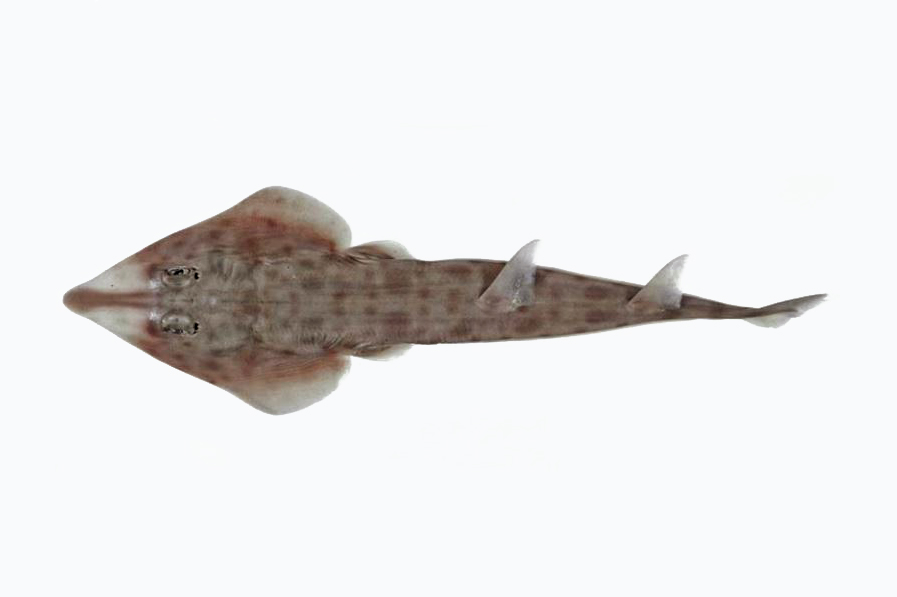Goldeneye Shovelnose Ray, Rhinobatos sainsburyi Last 2004

Dorsal view of the holotype of the Goldeneye Shovelnose Ray, Rhinobatos sainsburyi, (CSIRO H.4041-04), 506 mm TL, mature male, off northwestern Australia, eastern Indian Ocean. Source: Australian National Fish Collection, CSIRO. License: CC By Attribution-NonCommercial
Summary:
A pale yellowish-brown ray with or without faint dusky to golden blotches or fine dark spots, and no dark tip on the snout.
Cite this page as:
Bray, D.J. 2023, Rhinobatos sainsburyi in Fishes of Australia, accessed 01 Jul 2025, https://fishesofaustralia.net.au/Home/species/3272
Goldeneye Shovelnose Ray, Rhinobatos sainsburyi Last 2004
More Info
|
Distribution |
Monte Bello Islands, Western Australia, to north-west of Melville Island, Northern Territory. |
|
Features |
Vertebrae 185. Disc wedge-shaped, dorsal surface scaled but without thorns; snout short, snout length 2.5–2.6 times interspiracular distance; orbit moderately large, diameter 1.6–1.9 times spiracle length; nostrils oblique, length 1.4–1.6 times internarial distance; anterior nasal-flaps inserted well into internarial space, but never almost united near ventral midline; posterior nasal flaps broad; ridges of rostral cartilage well-separated dorsally and almost parallel; prebranchial sensory-pore patch narrow, extending to first gill slit; distance between first gill slits 1.3–1.4 times distance between fifth gill slits; distance between fifth gill slits 2.5–2.9 times in ventral head length; postscapular sensory canal long, not grooved, extending more than three-quarters distance to pectoral-fin insertions; moderately tall dorsal-fins; pelvic-fin inner margin distinctly longer than its base in mature males but shorter than base in females; interdorsal distance more than 2.5 times first dorsal-fin base; outer spiracular fold distinctly larger than inner fold; dorsal margin of caudal fin about 2.0–2.2 times preventral margin; 162–171 post-synarcual vertebral centra; about 50 nasal lamellae. |
|
Colour |
Body pale yellowish brown dorsally, with dense cover of faint dusky blotches (blotches sometimes absent or more golden); somewhat paler near hind margin of pectoral fin; paler yellowish to white on lateral snout, anterior edge of orbit, lateral cutaneous fold of tail, and between ridges of rostral cartilage; nasal capsules not sharply demarcated from lateral snout; snout tip and fins plain. Ventral surface uniformly white; no dark tip on snout apex. |
|
Biology |
Males mature at 460 mm TL. |
|
Etymology |
The species is named sainburyi in acknowledgment of the efforts of Dr Keith Sainsbury who planned and managed the initial trawl fish surveys of the continental shelf of northwestern Australia. His foresight in recognizing the need for documenting the fauna before attempting to address more management oriented questions is exemplary. This pioneering research has provided an excellent regional biological baseline that would otherwise be unavailable for regional marine management. |
|
Species Citation |
Rhinobatos sainsburyi Last 2004, Records of the Australian Museum 56(2): 205, figs 3-4. Type locality: 19°29'S 117°35'E, NE of Cape Lambert, Western Australia, 70 m. |
|
Author |
Bray, D.J. 2023 |
|
Resources |
Goldeneye Shovelnose Ray, Rhinobatos sainsburyi Last 2004
References
Gloerfelt-Tarp, T. & Kailola, P.J. 1984. Trawled Fishes of Southern Indonesia and Northwest Australia. Jakarta : Dir. Gen. Fish. (Indonesia), German Tech. Coop., Aust. Dev. Ass. Bur. 406 pp. (as Rhinobatos sp. 1 and Rhinobatos sp. 4)
Last, P.R. 2004. Rhinobatos sainsburyi n.sp. and Aptychotrema timorensis n.sp. —Two New Shovelnose Rays (Batoidea: Rhinobatidae) from the Eastern Indian Ocean. Records of the Australian Museum 56: 201-208 DOI: https://doi.org/10.3853/j.0067-1975.56.2004.1415
Last, P.R., Séret, B. & Naylor, G.J.P. 2016. A new species of guitarfish, Rhinobatos borneensis sp. nov. with a redefinition of the family-level classification in the order Rhinopristiformes (Chondrichthyes: Batoidea). Zootaxa 4117(4): 451-475 https://doi.org/10.11646/zootaxa.4117.4.1
Last, P.R. & Stevens, J.D. 1994. Sharks and Rays of Australia. Canberra : CSIRO Australia 513 pp. 84 pls. (as Rhinobatos sp. A)
Last, P.R. & Stevens, J.D. 2009. Sharks and Rays of Australia. Collingwood : CSIRO Publishing Australia 2, 550 pp.
McAuley, R.B. & Kyne, P.M. 2015. Rhinobatos sainsburyi. The IUCN Red List of Threatened Species 2015: e.T42721A68641936. https://dx.doi.org/10.2305/IUCN.UK.2015-4.RLTS.T42721A68641936.en. Downloaded on 04 November 2020.
Sainsbury, K.J., Kailola, P.J. & Leyland, G.G. 1984. Continental Shelf Fishes of Northern and North-Western Australia. Canberra : Fisheries Information Service 375 pp. figs & pls. (as Rhinobatos sp. 1, and Rhinobatos sp. 2)
Séret, B., Last, P.R. & Naylor, G.J.P. 2016. 10. Guitarfishes. Family Rhinobatidae. (pp. 70-109) in Last, P.R., White, W.T., de Carvalho, M.R., Séret, B., Stehmann, M.F.W. & Naylor, G.J.P. (eds) Rays of the World. Melbourne : CSIRO Publishing, 800 pp.
White, W.T., Last, P.R. & Naylor, G.J.P. 2016. Rhinobatos manai sp. nov., a new species of guitarfish (Rhinopristiformes: Rhinobatidae) from New Ireland, Papua New Guinea. Zootaxa 4175(6): 588-600 https://doi.org/10.11646/zootaxa.4175.6.6

